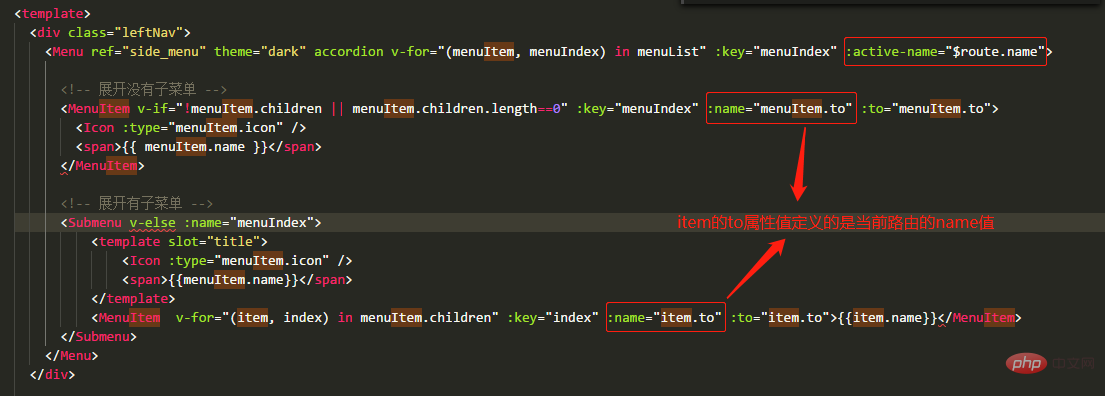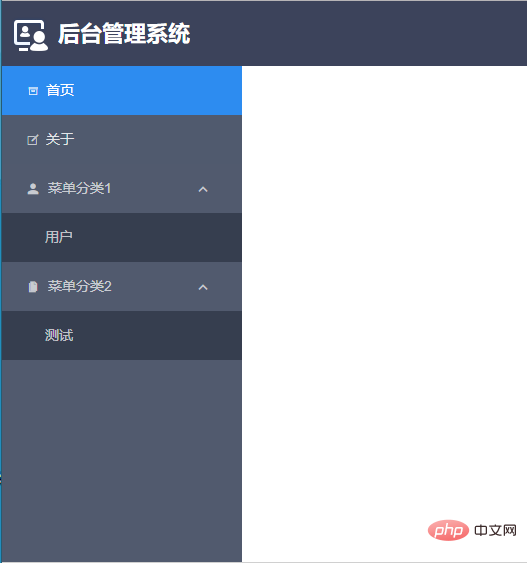 Web Front-end
Web Front-end
 JS Tutorial
JS Tutorial
 Example of implementing the dynamic menu function on the left using the vue+iview framework
Example of implementing the dynamic menu function on the left using the vue+iview framework
Example of implementing the dynamic menu function on the left using the vue+iview framework

Recently, when using vue-cli3 with the iview framework to build a new project, the menu menu in iview is used. It is not very good to fix it according to the official website writing method, because most projects are started from the back end. Dynamically obtain the menu list, so we need to slightly modify the official website code, the code is as follows:
Related learning recommendations: javascript tutorial
## Notes:
[1] The highlighted part of the menu is dynamically bound to the route jump page
There are some in the Menu component An active-name reflects the current highlighted area, so active-name can be dynamically bound to achieve highlighting. The premise is that the name bound to the MenuItem needs to be set to the name of the page route
[2] Dynamically obtain the menu data and update the menu
this.$nextTick(() => {
this.$refs.side_menu.updateOpened()
this.$refs.side_menu.updateActiveName()
});Code:
<template>
<p class="leftNav">
<Menu ref="side_menu" theme="dark" accordion v-for="(menuItem, menuIndex) in menuList" :key="menuIndex" :active-name="$route.name">
<!-- 展开没有子菜单 -->
<MenuItem v-if="!menuItem.children || menuItem.children.length==0" :key="menuIndex" :name="menuItem.to" :to="menuItem.to">
<Icon :type="menuItem.icon" />
<span>{{ menuItem.name }}</span>
</MenuItem>
<!-- 展开有子菜单 -->
<Submenu v-else :name="menuIndex">
<template slot="title">
<Icon :type="menuItem.icon" />
<span>{{menuItem.name}}</span>
</template>
<MenuItem v-for="(item, index) in menuItem.children" :key="index" :name="item.to" :to="item.to">{{item.name}}</MenuItem>
</Submenu>
</Menu>
</p>
</template>
<script>
export default {
data() {
return {
menuList: [
{
name: "首页",
to: "home",
icon: "ios-archive-outline"
},
{
name: "关于",
to: "about",
icon: "ios-create-outline"
},
{
name: "菜单分类1",
icon: "md-person",
children: [
{
name: "用户",
to: "user"
}
]
},
{
name: "菜单分类2",
icon: "ios-copy",
children: [
{
name: "测试",
to: "test"
}
]
}
]
};
},
created() {
// 数据我先写静态的,可在初始化的时候通过请求,将数据指向menuList。
// ajax成功回调后 this.menuList = response.data;
// 别忘记更新菜单
// this.$nextTick(() => {
// this.$refs.side_menu.updateOpened()
// this.$refs.side_menu.updateActiveName()
//});
}
};
</script>
<style lang="scss" scoped>
/deep/
.ivu-menu-dark.ivu-menu-vertical
.ivu-menu-item-active:not(.ivu-menu-submenu) {
border-right: none;
color: #fff;
background: #2d8cf0 !important;
}
</style>Rendering:

Programming Video
The above is the detailed content of Example of implementing the dynamic menu function on the left using the vue+iview framework. For more information, please follow other related articles on the PHP Chinese website!

Hot AI Tools

Undresser.AI Undress
AI-powered app for creating realistic nude photos

AI Clothes Remover
Online AI tool for removing clothes from photos.

Undress AI Tool
Undress images for free

Clothoff.io
AI clothes remover

Video Face Swap
Swap faces in any video effortlessly with our completely free AI face swap tool!

Hot Article

Hot Tools

Notepad++7.3.1
Easy-to-use and free code editor

SublimeText3 Chinese version
Chinese version, very easy to use

Zend Studio 13.0.1
Powerful PHP integrated development environment

Dreamweaver CS6
Visual web development tools

SublimeText3 Mac version
God-level code editing software (SublimeText3)

Hot Topics
 1662
1662
 14
14
 1419
1419
 52
52
 1311
1311
 25
25
 1261
1261
 29
29
 1234
1234
 24
24
 How to use bootstrap in vue
Apr 07, 2025 pm 11:33 PM
How to use bootstrap in vue
Apr 07, 2025 pm 11:33 PM
Using Bootstrap in Vue.js is divided into five steps: Install Bootstrap. Import Bootstrap in main.js. Use the Bootstrap component directly in the template. Optional: Custom style. Optional: Use plug-ins.
 How to add functions to buttons for vue
Apr 08, 2025 am 08:51 AM
How to add functions to buttons for vue
Apr 08, 2025 am 08:51 AM
You can add a function to the Vue button by binding the button in the HTML template to a method. Define the method and write function logic in the Vue instance.
 How to use watch in vue
Apr 07, 2025 pm 11:36 PM
How to use watch in vue
Apr 07, 2025 pm 11:36 PM
The watch option in Vue.js allows developers to listen for changes in specific data. When the data changes, watch triggers a callback function to perform update views or other tasks. Its configuration options include immediate, which specifies whether to execute a callback immediately, and deep, which specifies whether to recursively listen to changes to objects or arrays.
 What does vue multi-page development mean?
Apr 07, 2025 pm 11:57 PM
What does vue multi-page development mean?
Apr 07, 2025 pm 11:57 PM
Vue multi-page development is a way to build applications using the Vue.js framework, where the application is divided into separate pages: Code Maintenance: Splitting the application into multiple pages can make the code easier to manage and maintain. Modularity: Each page can be used as a separate module for easy reuse and replacement. Simple routing: Navigation between pages can be managed through simple routing configuration. SEO Optimization: Each page has its own URL, which helps SEO.
 How to return to previous page by vue
Apr 07, 2025 pm 11:30 PM
How to return to previous page by vue
Apr 07, 2025 pm 11:30 PM
Vue.js has four methods to return to the previous page: $router.go(-1)$router.back() uses <router-link to="/" component window.history.back(), and the method selection depends on the scene.
 React vs. Vue: Which Framework Does Netflix Use?
Apr 14, 2025 am 12:19 AM
React vs. Vue: Which Framework Does Netflix Use?
Apr 14, 2025 am 12:19 AM
Netflixusesacustomframeworkcalled"Gibbon"builtonReact,notReactorVuedirectly.1)TeamExperience:Choosebasedonfamiliarity.2)ProjectComplexity:Vueforsimplerprojects,Reactforcomplexones.3)CustomizationNeeds:Reactoffersmoreflexibility.4)Ecosystema
 How to use vue traversal
Apr 07, 2025 pm 11:48 PM
How to use vue traversal
Apr 07, 2025 pm 11:48 PM
There are three common methods for Vue.js to traverse arrays and objects: the v-for directive is used to traverse each element and render templates; the v-bind directive can be used with v-for to dynamically set attribute values for each element; and the .map method can convert array elements into new arrays.
 How to reference js file with vue.js
Apr 07, 2025 pm 11:27 PM
How to reference js file with vue.js
Apr 07, 2025 pm 11:27 PM
There are three ways to refer to JS files in Vue.js: directly specify the path using the <script> tag;; dynamic import using the mounted() lifecycle hook; and importing through the Vuex state management library.



